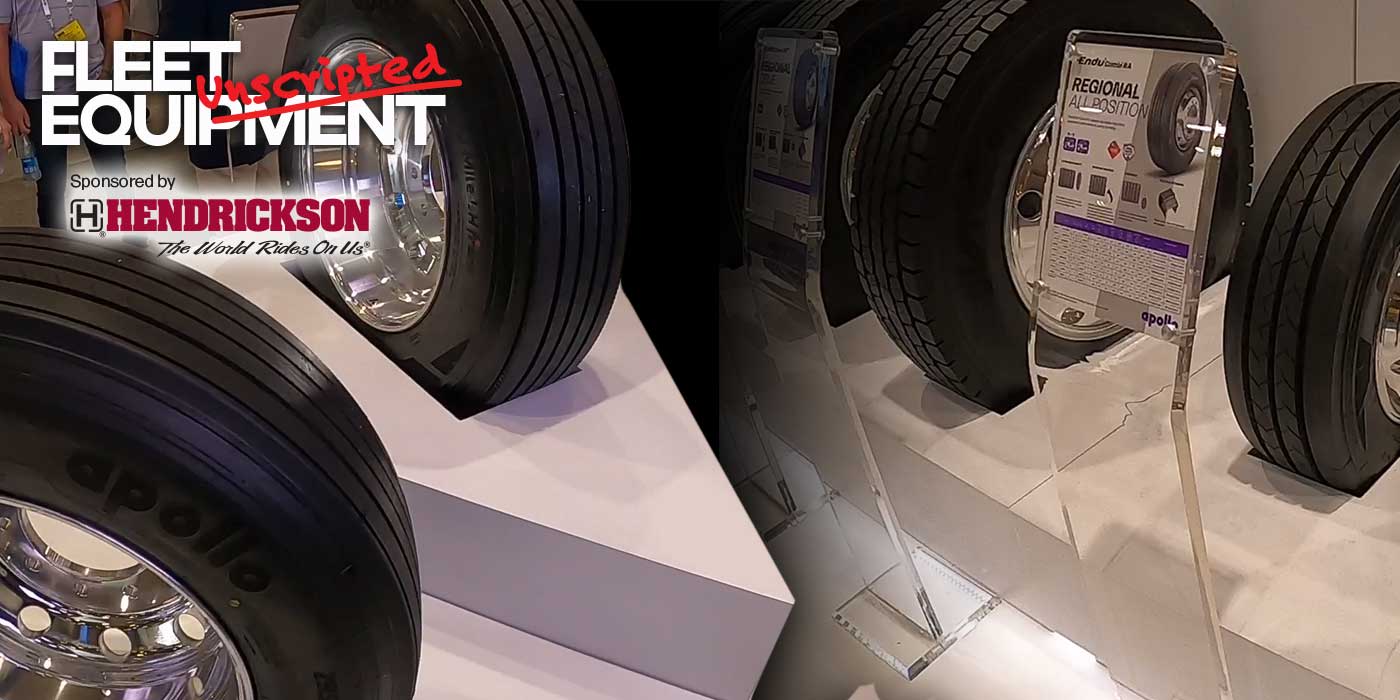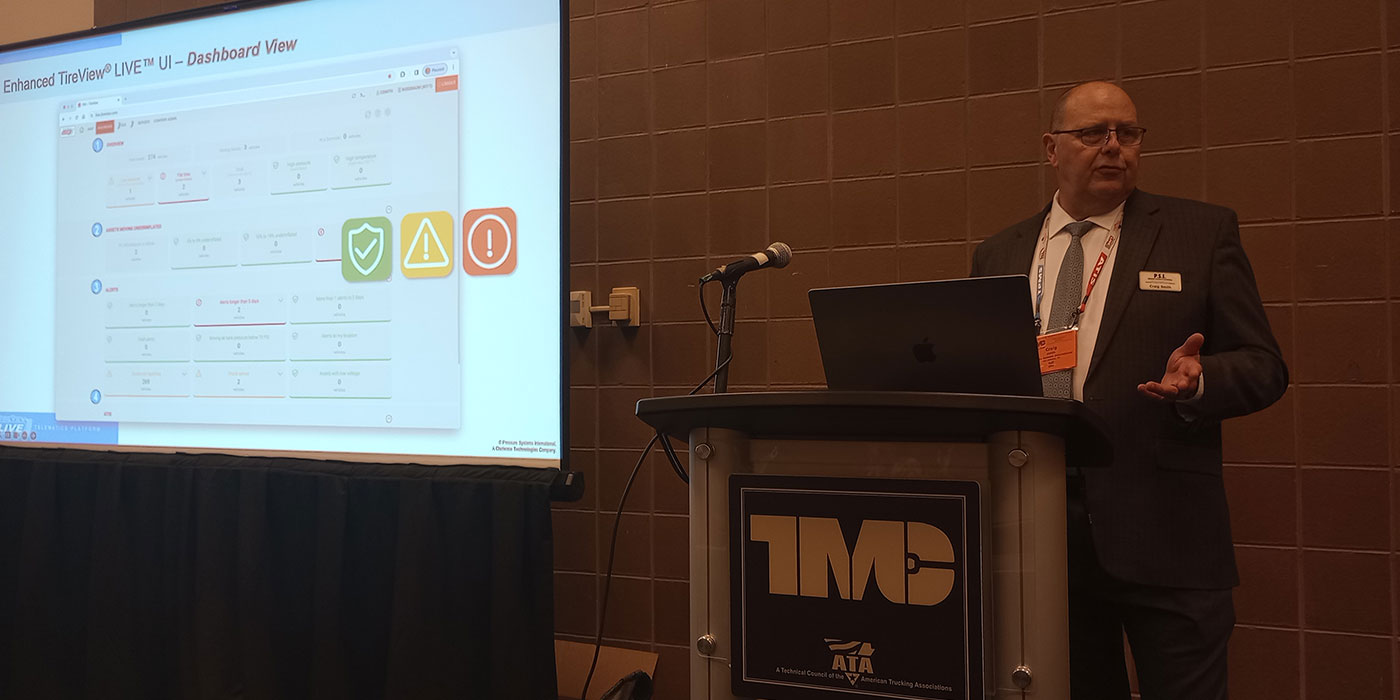3% lower depending on specific tire size). This is because the four dual tires do not each carry the same load due to technical issues such as unbalanced loads and crown of the road.
Dual loads are lower vs. running the same tire size as a single to protect the tire that carries the highest load. An example: 295/75R22.5 LR G tire is listed in the table (dual tire) at 5,675 lbs. at 100 psi. The same size running as a single tire is rated at a higher load of 5,780 lbs. at 100 psi (105 lbs. higher load capacity as a single). The tables also show that if your actual tire loads are less, let’s say, a maximum of 5,000 lbs./tire (295/75R22.5), it would be acceptable to run only 85 psi and still carry the load.
There are many service vocations such as logging, where a vehicle may run at 65 mph on the highway but then must go on an unpaved road to pick up the logs for a few miles. These roads typically have a maximum speed allowed of 35 mph to keep severe road-rutting from occurring. Because speed is a variable that can change normal recommended load/inflation ranges, there are tables that will show a higher load capacity if a vehicle has a low maximum speed.
For example: 35 mph max speed, 11R24.5 tire size – According to the low speed load/inflation table, if your maximum load per tire is 5,500 lbs. and your max speed is 35 mph, you can run at 74 psi. Lower pressure in the tire will allow a longer tire footprint, which spreads the load over a larger surface area, helping to extend the service life of the road itself. Since an operation like logging runs at two distinctly different maximum speeds (65 mph vs. 35 mph), the inflation pressure in the tires should be adjusted as the maximum allowed speed changes.
There is even a load/inflation table that shows the load change and pressure change associated with running at a variety of speeds. If you have a vehicle just creeping along (moving the space shuttle into position is a good example), the maximum tire load can more than double from the normal published load, as long as you increase the pressure 40 psi. Another example from the same table shows that if you have a vehicle that never goes higher than 30 mph, the load can increase 24% with a 10 psi increase in inflation pressure.
Bottom line: Work with your tire professionals to determine that you are running the appropriate pressure for the loads you are carrying based on your maximum speed.
How Old is Too Old?
The debate about how age affects tires continues. For instance, some fleets say five years is their magic number before retirement, while others say as many as 10 years is acceptable.
As rubber is bombarded by weather and ultraviolet rays year after year, the compounds can develop weather/ozone-related cracking. These same compounds can become “stiffer” as the tire ages.
Questions about how age affects tires have been discussed for many years with fleets, new tire manufacturers and tire retreaders. Currently there are several industry task forces looking into what are acceptable age limit for tires:

• How long can a tire sit in a warehouse before it is put into service?
• Can a tire be stored outdoors for extended periods of time?
• How old can a casing be before it is retreaded?
To maximize a fleet’s tire budget by using tires as long as they are useful, but not too long, it’s important to be able to calculate the age of specific tire casings. You can do this by looking at all of the Department of Transportation (DOT) numbers branded on the tire sidewall.
Understanding how to read a DOT number is very important. You certainly do not want to mount a “new” tire that has been sitting in some warehouse for the last five years! Nor do you want to discard a tire before its useful life is done.
The Federal government mandates that all tires be stamped with a DOT number when the tire is manufactured, regardless if it was produced in the U.S. or outside the country. If a truck tire is used domestically, then it must have a DOT number.
In addition, every time a casing is retreaded, a specific retread DOT number must be branded on the tire sidewall, as well. Any tires that are manufactured and imported from outside the U.S. should be checked to make sure that the DOT is clearly visible on the tire sidewall (only one side of the tire is required to have the DOT number). If there is no DOT number, do NOT mount that tire on any equipment.
To use this information to its full potential, it’s important to know what the number means. A tire DOT number is not just a series of digits, but rather a code that defines particulars about that tire. DOT numbers are comprised of 11 digits. From an age standpoint, the last four digits will tell you the week and year the tire was produced.
So, if the last four digits are 0209, that would mean that the tire was manufactured the second week of 2009; 2604 equates to the 26th week of 2004.
Retread numbers are longer – 13 digits beginning with the letter “R” followed by a 3-digit “retread manufacturer ID code.”
Every retread facility is assigned a three digit code by the government. It is very critical to know which retread facility capped your casing in case there are any performance issues down the road. Click here to find a list of all retreaders’ assigned numbers.
As with a new truck tire’s DOT number, the last four digits in a retread number designate the week and year in which the casing was retreaded. By law, the retread DOT number must be permanently applied to the tire every time that tire is retreaded, so you can determine the number of times a specific tire has been retreaded and also the age of the casing. Many fleets have a specification as to the number of times they will allow a tire to be retreaded.
All of the digits of the new tire DOT and retread DOT number that come before the last four digits are codes that identify the manufacturing plant, tire size and tire type. For the most part, this is not particularly important information to find in the DOT number because the tire brand and size are clearly visible on both tire sidewalls.
However, it is important to some fleets to record the entire DOT number in their record keeping systems, particularly if they want to analyze the correlation between tire performance and specific brands, tire types and sizes, and weeks of production. A good database system could take this information to identify trends that could be very useful to know. It might point out reasons to rethink tire purchasing decisions or give you details to help a fleet get more from its tire budget.
What To Do With Data
Every fleet wants to have the very best tire program. The goal is to maximize tire life and fuel economy, minimize tire related roadside service calls, and maximize the number of retreads. It is not an easy task because it takes generating serious tire performance data, which unfortunately takes a significant amount of time and a lot of manual labor.
Even tracking tire mileage is difficult. The easy method is to record the odometer or hubometer reading when the tire is first mounted and then again when the tire comes out of service.
You also need to record the tread depth at the lowest spot on the tire. If your removal specification is 6/32-inch of remaining rubber and a tire is removed at 8/32-inch or 10/32-inch, the mileage calculation would be misleading. It would be impossible to always hit the exact remaining tread depth spec. Therefore, only looking at final removal miles will not tell the fleet manager the entire story. You also need to look at treadwear measured in miles per 32nd.
As an example: if a steer tire starts out at 20/32-inch tread depth, is taken out of service at 120,000 miles with 8/32-inch of rubber remaining, miles per 32nd equals 120,000 divided by 12 (the difference between 20/32-inch and 8/32-inch), which gives you 10,000 miles/32nd. Tires running on the steer axle will have different miles/32nd compared to tires running at either the drive or trailer positions.
Tires on the first drive axle will have a different wear rate vs. tires on the second drive axle because when a vehicle turns, the pivot point is the first drive axle. That means that the tires on the second drive axle tend to scrub as they are rubbed somewhat sideways with each turn. As a result, they have a faster wear rate. The more turning a tractor does, the bigger the difference in miles/32nd between the tires on the first and the second drive axles. It is very important to compare apples to apples – tires at each axle position – when reviewing miles/32nd tire data.

What About Retreads?
Since 90% of fleets run retreads, tracking retread miles/32nd data is important. Happily, retread performance data is generated the same way as for new tires. But when you go to analyze the data, you’ll want to keep the results separate from new tire performance.
Another piece of the puzzle is retreadability. You can only measure retreadability by keeping track of how many times a casing is retreaded. This requires working very closely with a retreader. If the fleet’s goal is two retreads per tire casing and you discover that you are only averaging 1.5 retreads for trailer tires, you need to start analyzing why. Is it a specific tire design or type? Is it because tire inflation pressures are running 10% too low? Is it because loads are too high or the truck is running too fast? There are lots of questions to ask and answer, and it takes time and much data to reach the proper conclusions.
Measuring tire fuel efficiency or fuel economy gains from tires is really tough for even the most experienced fleet manager.
Tractors are not always married to the same trailer, loads vary, drivers vary, tires vary, and routes vary. To calculate the effect that tires have on fuel economy, you need to keep track of miles/gallon for each individual tractor and have a really large sample size to nullify all the variables that come into play. Tracking three or four tractor-trailers will not tell you anything conclusive when it comes to the effect that tires play in the fuel economy equation.
Keeping track of tire-related roadside service calls is probably the easiest to follow, but it is difficult to analyze without good, solid data. Why did the tire have downtime to begin with? Did it hit the curb? Did it run with little or no air for an extended period of time? Or did it run over every nail on the back roads? Again, this takes serious data to answer these questions, but you need to know the answers so you can design the best possible tire program for your fleet.
Tires are the second highest operational cost next to fuel, so it is clearly worth the effort to capture the appropriate data and make good, solid business decisions. The worst scenario is to make tire decisions based on perceptions. You need real data from the real world.




